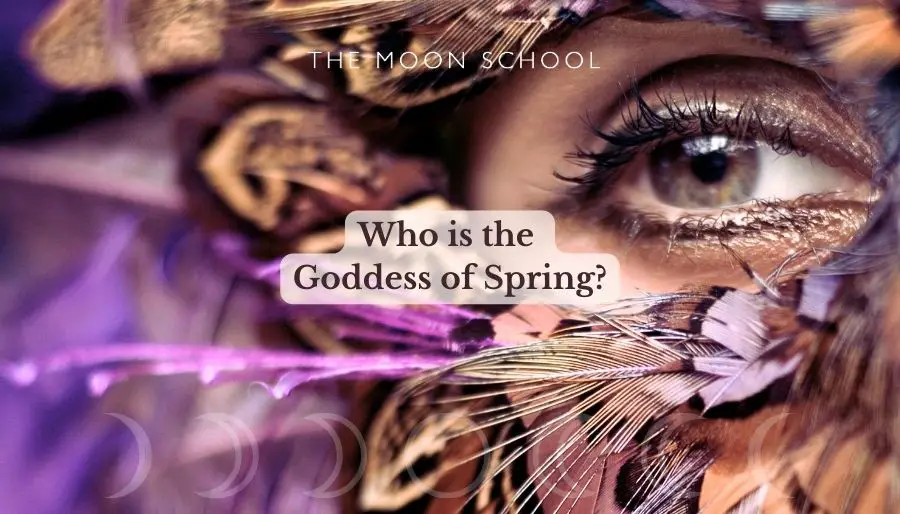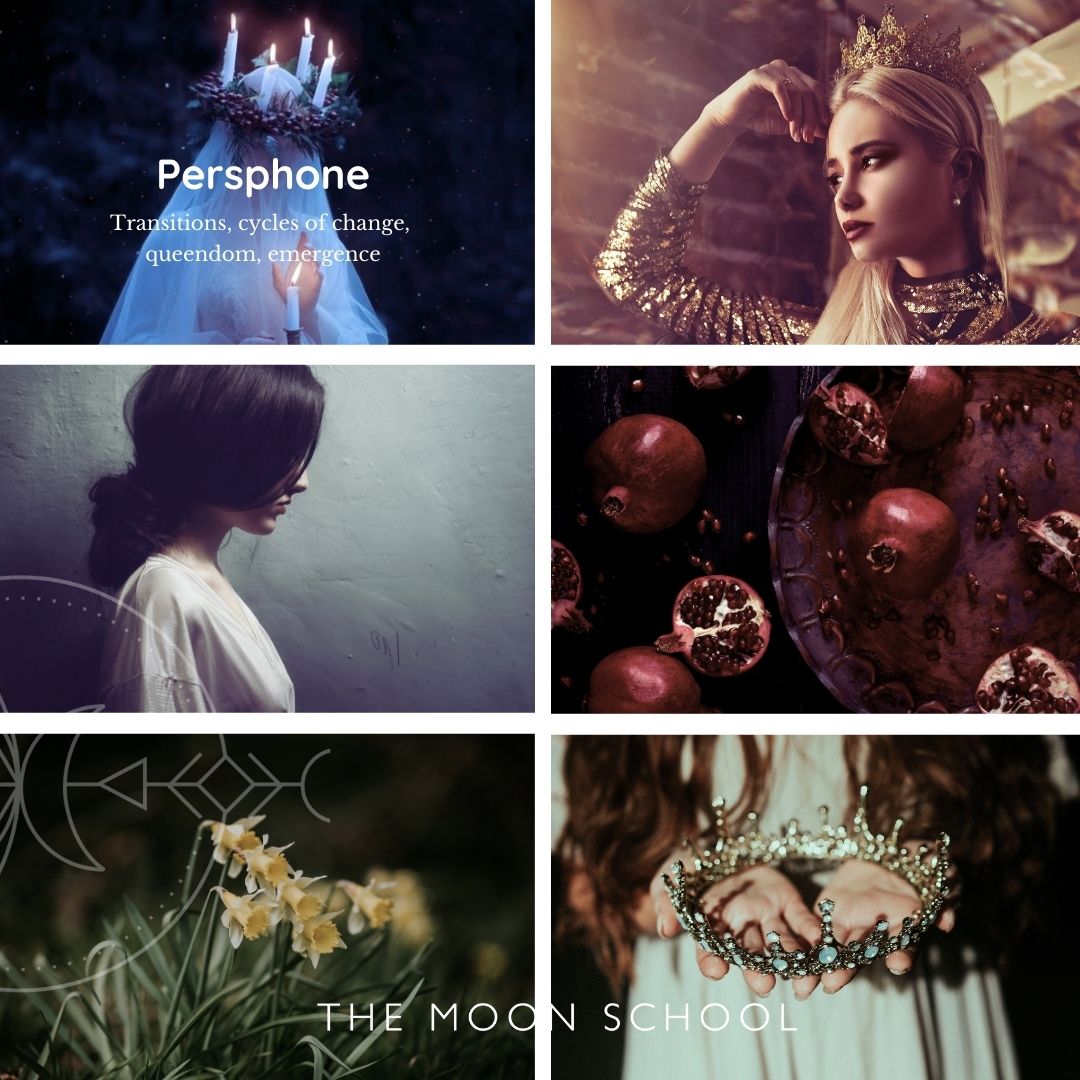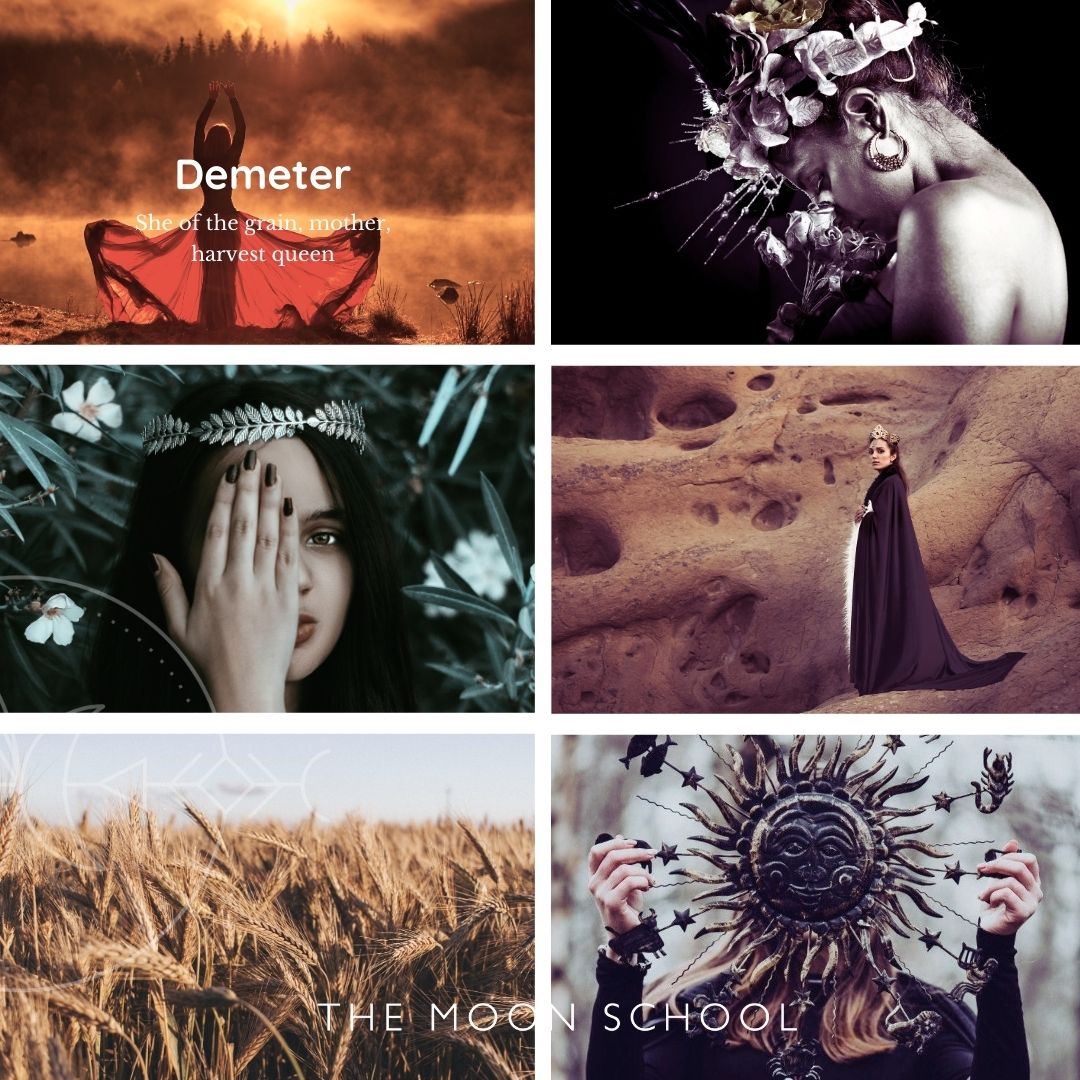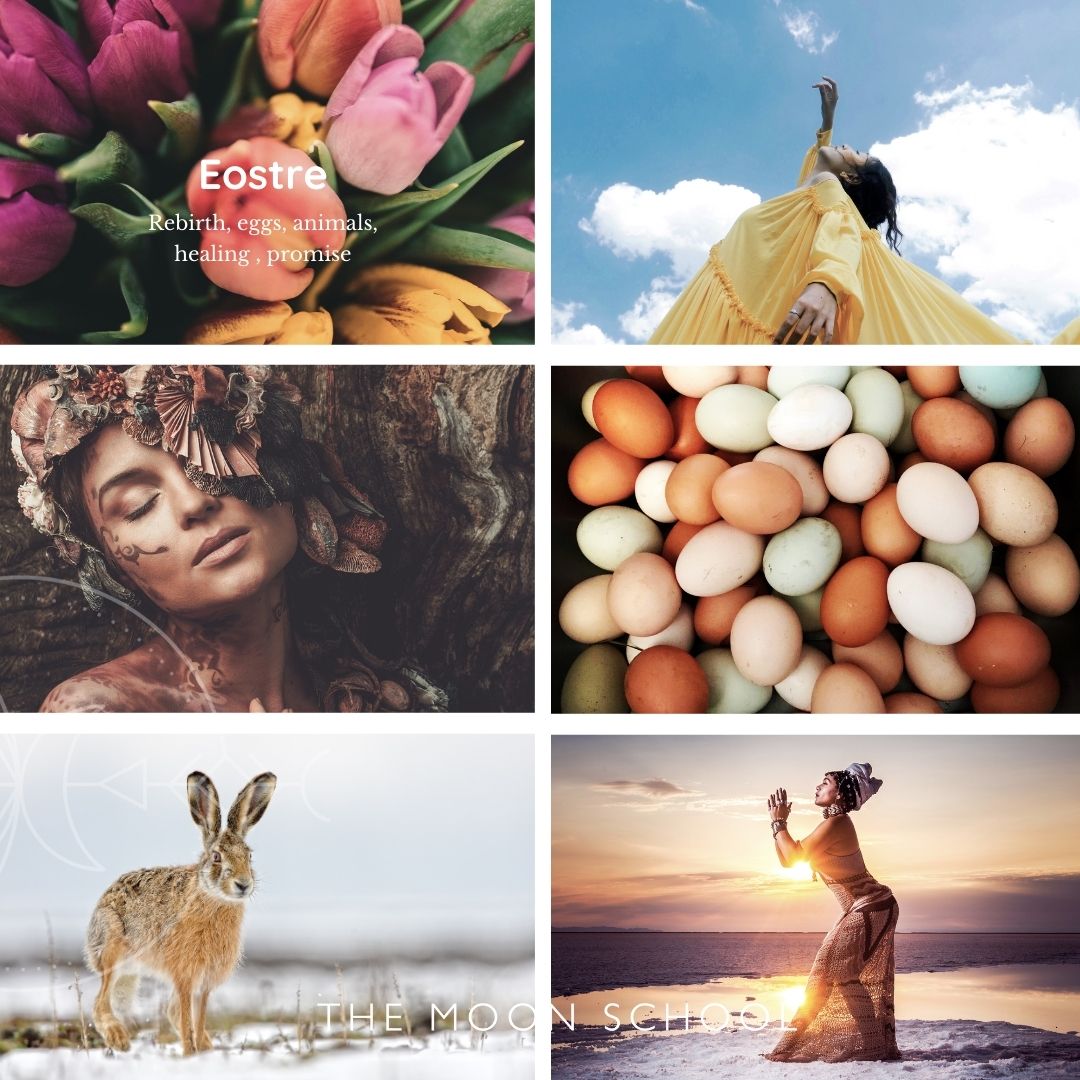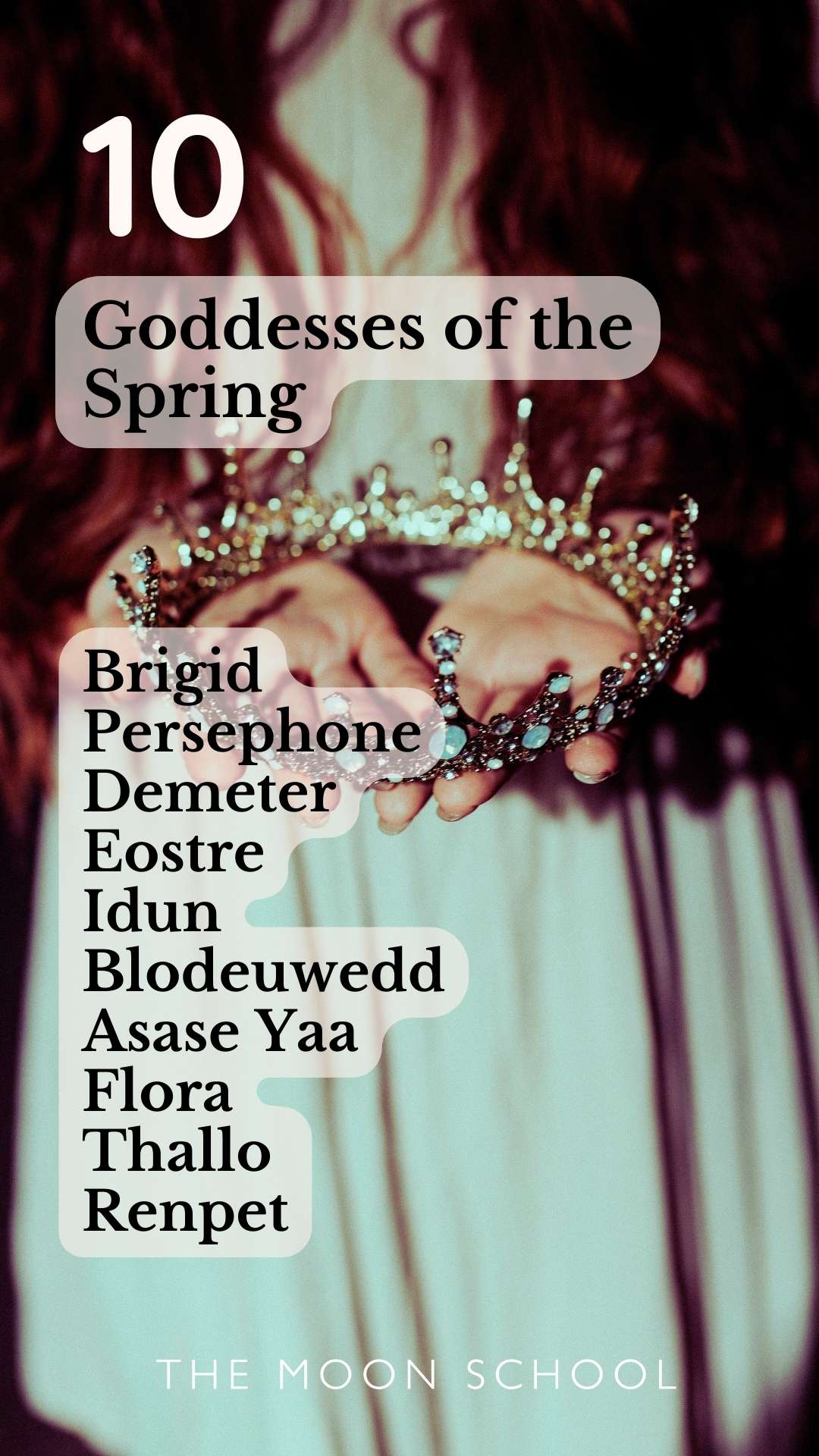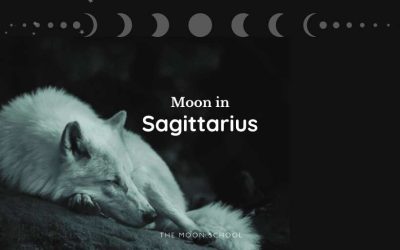Hello, beautiful, bounteous Springtime!
Spring is a season we all look forward to (right?) – the harbinger of new beginnings, fresh growth, and long-awaited renewal. It is a time when Mother Earth awakens from her winter slumber, the Sun begins to glow a little stronger, and the world is once again filled with vibrant colors, scents, and sounds.
From Greek mythology to the Banks of the Nile, many cultures throughout history have celebrated the arrival of the season, by honoring a specific goddess of spring. For many ancient peoples, these spring goddesses were believed to be responsible for the renewal of life after the winter season, and the bringing of balance at Spring Equinox.
Honoring these deities not only guaranteed that they kept their promises of transforming the winter season into spring, but it kept them alive in the collective psyche of the time. This is something we modern folk have all but lost. But not completely – so let’s dive into the mythology of some of these irresistible spring goddesses, and look into ways we can call on them today…
Who is the Goddess of spring?
As you’d expect, goddesses of spring are deities associated with the Spring season, and some are specifically connected to the Spring equinox (when day and night are of equal length).
Often depicted as a young woman, the goddess of Spring full of life and vitality! Her role is to bring new life to the world, to help plants grow, and to ensure the Earth is fertile and full of abundance.
A goddess of spring is often recognizable as a fertility goddess, maiden goddess, or earth goddess who is beautiful, youthful, and surrounded by fruits flowers, and animals. But regardless of the details, these spring goddesses are celebrated as they usher in a time of growth and renewal.
Qualities, traits and characteristics of Spring Goddesses
Despite manifesting a little differently around the world, Spring goddesses share certain qualities. Here’s a list of the kinds of traits and characteristics expressed in these sacred personifications –
- Renewal
- Fertility
- Growth
- Rejuvenation
- Beauty
- Grace
- Abundance
- Nurturing
- Vitality
- Blossoming
- Joy
- Warmth
- Awakening
- Transformation
- Youthfulness
- Creativity
- Harmony
- Hope
- Light
- Radiance
10 Spring Goddesses
There are countless deities associated with different aspects of springtime (and many gods, though their stories will be saved for another day). Some have endured, whilst others, we may never hear their name or story again… We’ve selected a handful from different pantheons.
1. Brigid
Brigid is my favorite of all the Spring deities. As keeper of the flame, Brigid is the ancient Irish Goddess of Healing, Poetry, Silversmithing, and Midwifery. Also known a Bride, Brigit, Briget, and Brighid, her feast day falls on Imbolc, which is February 1st each year.
Myth of Brigid
According to the Lebor Gabála Érenn (an origin legend of the Irish people), Brigid was a daughter of the Dagda (high chief of all the Gods), she had two oxen, Fea and Femen, and also possessed the “king of boars”. It’s said that when Ireland was plundered, these animals would cry out.
Brigid appears in many different stories across the Celtic lands – from Ireland and Scotland to Wales and Gaul, a red-haired, wild, female deity known as the “high one” offers healing, protection, and inspiration to her followers.
At Kildare in Ireland, Brigid takes the role of the keeper of the eternal flame, where she tended a sacred fire that is still kept alive today.
Despite being a Celtic Goddess, Brigid was adopted by early Christians, becoming Ireland’s patroness saint. This describes just how powerful a deity she was – many Celtic Goddesses and their stories were all but wiped out by crusaders and colonizers. Brigid was, instead, canonized.
Brigid’s power + associations
Brigid is a triple Goddess, meaning she has three aspects – Maiden, Mother, and Crone. Yet it’s in her maiden form that this Goddess is often welcomed in the Spring – specifically at Imbolc when followers gather to honor and worship her. The wintery crone is being put to sleep and the maiden ushers in the Spring, bringing regeneration and renewal.
As a patroness of healing, Brigid offers comfort and support to those in need, and can be a powerful ally for those working in the healing professions.
Her connection to fire, and it’s transformational power can be called upon in times of personal change and transition. Brigid also offers us creativity, and the spark of initiation needed to craft things anew.
As protector of women and children, Brigid is also a beautiful guide and spirit to work with if you are pregnant, or want to be pregnant. There are many describing Brigid’s compassion, where she’s said to have comforted and aided women and children, particularly those in childbirth.
Symbols + offerings for Brigid
- Brigid’s cross, a woven symbol of protection
- White flowers, particularly snowdrops, and daisies
- Candles (a flame)
- Milk or dairy products
- Brigid’s wheel (a solar cross representing the turning of the seasons)
- Healing herbs, such as lavender and chamomile
- Poetry and creative writing
- Silver jewellery
- Sacred wells, water, and dew
2. Persephone
Persephone is perhaps the most famous Spring goddess in Greek mythology. Known as Queen of the Underworld, her story is often seen as a metaphor for the changing of the seasons.
Myth of Persephone
According to the Greek myth, Persephone was the daughter of Zeus and Demeter, and she was abducted by Hades, the God of the underworld while out picking flowers.
In some versions of the myth, Persephone ate pomegranate seeds while she was in the underworld, which bound her to Hades, where she takes her throne as Queen of the underworld. Grief-stricken, Demeter abandoned the earth causing it to become barren. Zeus (King of the gods) intervened and negotiated Persephone’s release for half of the year.
The myth provides a profound metaphorical explanation of the changing seasons, as Demeter’s joy at her daughter’s return brings about the spring and summer seasons while her sorrow during Persephone’s absence when she’s with Hades results in autumn and winter.
Persephone’s power + associations
As a Greek Goddess of the Spring, Persephone holds the power of transitions, and she can teach us about our own personal seasons of growth and change. So if you need support moving through the cycles of your life, including ego death and the releasing of old masks, she’s a great guide to call upon.
Persephone begins her myth as a Maiden. But by the end, she has become Queen of the underworld, fulfilling her potential and rising into an entirely new way of being. So she can lead us into our truth, enabling us to take our seat on the throne of our own lives, by realizing who we really are.
Also read: 13 Formidable Examples of the Dark Goddess
Symbols + offerings for Persephone
- Pomegranates, seeds + juice
- Seeds of grain
- A crown
- Flowers (especially narcissus + other spring bulbs)
- Floral scents
- Flower crowns or garlands
- Springtime
- Deer
3. Demeter
Another greek Goddess, Demeter was the wife of Zeus and mother of Persephone, and was also associated with the arrival of Spring. As the goddess of grains, agriculture, and the harvest, Demeter was known as “She of the Grain” and was often depicted holding a bundle of wheat or corn.
Myth of Demeter
Demeter was devastated when her daughter Persephone was abducted by Hades. In her grief, the goddess of agriculture, neglected the land, causing the earth to become barren and lifeless.
To save humanity from starvation, Zeus negotiated Persephone’s return, but because Hades had already tricked her into eating pomegranate seeds, she was bound to the underworld. So the agreement was made, for Persephone to spend part of the year above, and part below ground.
In this myth, the two goddesses control the seasons, and it’s Demeter’s joy at her daughter’s return, that brings about spring, while her sorrow during Persephone’s absence results in winter.
Demeter’s power + associations
In Greek mythology, Demeter is the goddess of agriculture and the harvest. Yet as the mother of Persephone, she’s also strongly associated with fertility and motherhood. Her powers are closely tied to the fertility of the earth, and she is often depicted as a nurturing and protective figure.
Demeter is a Greek goddess strongly connected to grain, particularly wheat, as well as the bountiful abundance of the harvest.
Because Demeter’s influence extends to the natural world, the ancient Greeks also honored her, for her role in nurturing and sustaining all living things. This is something that carries through to today with some modern women also calling her into being through their own work in the world.
Symbols + offerings for Demeter
- Sheaf of wheat or barley
- Cornucopia (horn of plenty)
- Sickle
- Torch
- Poppies
- Mint
- Honey
- Bread
- Milk
- Winged serpent
- Screech owl
- Turtle dove
4. Eostre
Of all the Spring goddesses, Eostre maybe the most well-known. Eostre was the Anglo-Saxon goddess of spring and fertility. She was often associated with the spring equinox and the resurgence of life after winter. She was said to have the power to bring new life to the earth.
Also read: Spring Equinox: 5 Uplifting Rituals to Elevate You From a Winter of Shadow!
Myth of Eostre
According to folklore, the Germanic goddess of spring and fertility found a wounded bird and transformed it into a hare so that it could survive. The hare then laid eggs as a sign of gratitude to the goddess.
This hare became a symbol of Eostre and her festival, and it’s thought that this later became Christianized, as Easter.
Some also connect Eostre to the pagan celebrations centered around Spring or Vernal Equinox, also known as Ostara.
Eostre’s power + associations
Eostre’s story encompasses the eternal spring themes of rebirth, new beginnings, and the cycle of life. As a goddess of the dawn, she embodies the awakening of nature after the dormancy of winter.
Her story also reveals a healing influence, so she’s a deity who may be called upon for help and support with any healing work, especially when it involves animals.
In her myth, Eostre was associated with the hare which is a sacred animal, and a well-known symbol of fertility. Like the egg, she brings promise – often miraculous promise. Many people perceive her as a fertility goddess, and she was likely revered for this reason, in ancient springtime traditions.
Eostre’s power lies in the transformative energy of the spring season, inspiring hope, growth, and the flourishing of life.
Symbols + offerings for Eostre
- Hare
- Eggs
- Spring flowers (daffodils, tulips, etc.)
- Seeds
- Yellow, orange or white candles
- Incense with floral scents
- Honey
- Milk
- Baked goods
- Brightly colored ribbons
5. Idun
In Norse mythology, Idun is the goddess of spring and youth, and the wife of Bragi the God of poetry. The Norse goddess is known for her association with rejuvenation and the preservation of youth and vitality. Idun is the keeper of the golden apples, which grant immortality to the gods and goddesses.
Myth of Idun
In one notable myth, the trickster God Loki lures Idun out of Asgard (the realm of the gods) and into the hands of the giant Thiassi, who kidnaps her. But as a result, the gods begin to age and weaken without the nourishment of Idun’s golden apples.
Once the Gods realized what was happening, they forced Loki to rescue Idun. He does this by shapeshifting into a falcon and turning Idun into a nut (or in some myths, a sparrow) and flying away clutching her in his talons.
The myth reveals Idun’s crucial significance in maintaining the eternal youth and vigor of the divine realm.
Inun’s power + associations
Idun’s myth underscores the importance of renewal and the everlasting cycle of life.
Her role as the keeper of the golden apples signifies her ability to bestow immortality and eternal youth upon the gods and goddesses of Asgard, and this serves as a reminder of our own potential for renewal. For this reason, she is a great deity to call upon for assistance when shedding skins and facing ego deaths. Idun has the power to hold us through transitions, helping us to be reborn.
Revered for her ability to maintain perpetual youth, Idun can bring an energizing, vigorous energy when summoned. Working with her can help invigorate and shake up tired routines, or mundane attitudes.
Symbols + offerings for Inun
- Golden apples
- Spring flowers such as daffodils and lilies
- Floral wreaths or garlands
- Youthful imagery (such as depictions of young maidens)
- Fruit offerings, particularly apples
- Symbols of eternal youth, such as the eternal knot
- Spring water or mead
- Falcon
- Nuts
6. Blodeuwedd
Blodeuwedd was the Welsh goddess of spring and fertility and a significant figure in Welsh mythology.
Her name means the Flower Faced, and she’s often depicted as a symbol of transformation and the blossoming of nature, embodying the vibrant energy of spring.
Myth of Blodeuwedd
According to the Mabinogion, Blodeuwedd was created by the magician Gwydion from the blossoms of nine plants: Oak, meadowsweet, broom, bean, chestnut, cockle (burdock), nettle, primrose and hawthorn. She was destined to be the wife of Lleu Llaw Gyffes, whose mother (the goddess Arianrhod) had placed a kind of curse upon him, so that he may never marry a human wife.
However, Blodeuwedd’s loyalty waned over time and she fell in love with another man named Gronw Pebr. Together, they plotted to overthrow Lleu. When the plot was discovered, Lleu transformed into an eagle and flew away.
Gwydion the magician eventually found him and turned him back into a man, but as punishment for their actions, Blodeuwedd was transformed into an owl, forever destined to roam the night alone.
Blodeuwedd’s power + associations
The myth of this Welsh deity reflects themes of betrayal, transformation, and the consequences of defying natural order. Yet it also shines a light on the power of change, independence, and the natural cycle of growth that we all must move through.
So Blodeuwedd is a compelling and complex representation of the seasonal and emotional transitions associated with the arrival of spring.
Formed from flowers, Blodeuwedd is a goddess of magic and innocence. She brings purity to the magical work she’s called into, yet she also knows her mind and is unafraid to follow her heart.
Those who worshipped Blodeuwedd would call on her for support in initiation ceremonies, and at the point of new beginnings. She was said to have the power to bring new life from the soil, and was therefore revered as an earth goddess.
Blodeuwedd is also known as the Ninefold Goddess of the Western Isles of Paradise.
In some myths, Blodeuwedd was associated with the goddess Ceridwen, who was said to have the power to brew a potion of wisdom.
Symbols + offerings for Blodeuwedd
- Flowers of oak, meadowsweet, broom, bean, chestnut, cockle (burdock), nettle, primrose and hawthorn.
- Other blossoming blooms
- Owl, owl feathers, or depictions of owls
- Jewelry adorned with floral motifs
- Corn or grain offerings
- incense, particularly with floral scents
7. Asase Yaa/Afua
Asase Yaa/Afua is a prominent goddess in the traditional religion of the Akan people of Ghana and the Ivory Coast.
Actually two deities, Asase Yaa is usually defined as an old woman, sometimes known as “Old Mother Earth”, connected to the most barren places on earth, and to death. Asase Afua is worshiped as the Goddess of the fertile places, and depicted as a young, beautiful priestess woman who is associated with fertility, farming, abundance, and the nurturing of the land.
Myths of Asase Yaa/Asase Afua
Asase Ya was the wife of the sky God Nyame, the great creator of all things. She had two children – Bia and Tano, According to some folklore, Asase is also the mother of the trickster Anasi who takes the form of a spider.
Asase Yaa means “Female Born on Thursday” because it’s believed that Nyame created the earth on a Thursday. As such, it’s regarded as sacred, with no land work permitted, and no burying of the dead.
Asase Yaa/Asase Afua’s power + associations
Asase Yaa is a very powerful deity – second only to the divine creator – though no temples are dedicated to her. Instead, she is worshipped in the fields and homes.
Asase Yaa is often depicted as a motherly figure, symbolizing the bountiful and life-giving nature of the earth. She is honored for her role in sustaining and providing for the people, as well as for her connection to the cycles of agriculture and the natural world.
Asase Yaa is deeply respected by the Akan people, for her ability to nourish and support life, making her a central figure in Akan spirituality and cultural practices.
Symbols + offerings for Asase Yaa/Asase Afua
- Earth and soil
- Seeds and grains
- Clay pots
- Sacred water and libations
- Cowrie shells
- Harvested crops and fruits, as offerings of gratitude
- Woven baskets
- Decorated gourds
8. Flora
Flora was the Roman goddess of flowers and held a strong connection to the Spring, and the fertility of nature. Her name means “flower” and she was often depicted wearing a flower wreath or crown, surrounded by an abundance of creatures, plants, and other symbols of plenty.
Myths of Flora
Flora was considered a minor deity, meaning she doesn’t take a starring role in many Roman myths, however, she appears in quite a few.
One story in Roman mythology tells of her marriage to Zephyrus, the west wind. It’s said that Zephyrus fell in love with Flora and transformed himself into a gentle breeze, which carried her away to a meadow filled with flowers. There, he showered her with blossoms, creating a beautiful garden in her honor.
So important was this deity to the ancient Romans, that they dedicated an entire festival to her: The Floralia. Celebrated from April 28 to May 3, it marked the arrival of spring and the blossoming of buds. Floralia was characterized by vibrant celebrations, including theatrical performances, games, and the offering of flowers to Flora’s temple.
It was a time of feasting, dancing, and revelry, with participants adorned in colorful clothing and floral wreaths. The Floralia was a joyous occasion, symbolizing the rejuvenation of nature and the abundance of the spring season.
Flora’s power + associations
Flora embodies the rejuvenating energy of spring and the sheer beauty and joy inherent in the natural world.
Closely connected to the land, Flora is a wonderful deity to work with if you are a keen gardener, herbalist, or grower of plants. She will lovingly bestow her blessings on new growth – physical and metaphorical! So if you need some support to “blossom” in any area of life, consider calling on Flora.
Symbols + offerings for Flora
- Flowers, especially roses, lilies, and other blossoms
- Floral wreaths and garlands
- Cornucopia
- Perfumes and scented oils, particularly floral fragrances
- Offerings of honey and sweet fruits
- Floral-themed jewelry or accessories
- Butterflies and other pollinators
9. Thallo
Thallo is a little-known goddess from Greek mythology associated with the green shoots of spring. Little is known about her, but she was worshipped in Athens, spoken by name in an oath that all citizens of Athens had to swear.
It was believed Thallo had the power to ensure green shoots grew, and buds blossomed.
10. Renpet
There isn’t full agreement about whether Renpet was a real Egyptian Goddess, or simply a glyph, depicting a word or idea.
Her hieroglyph appeared as a young woman with a palm frond above her head. Renpet means “year”, “time” and also “Mistress of Eternity”.
She is depicted as a young woman wearing a palm shoot over her head. The palm shoot represented “time” and this glyph regularly appears on monuments and documents throughout Egyptian history as the beginning of the phrase recording the regnal year of the pharaoh.
How to work with Goddesses of the Spring
Working with goddesses of the spring can be a powerful way to connect with the energy of the season and tap into the energy of renewal that is all around us at this time of year.
Here in the West, are have been largely disconnected from our own pantheon of deities, and their myths and stories.
This leaves us cast adrift, trying to navigate the landscapes of our underworld alone, and looking outside of ourselves for guidance, instead of within.
But working seasonally with goddess energy is a really simple way back to truth and connection.
Here are some tips to help you work with the goddess of Spring that most calls to you –
- Do your research. Read a greek myth, pick up a book on local folklore, or seek out online groups with experts.
- OR… meditate and do shamanic journeys, requesting the gods orr goddesses you most need show themselves to you.
- Create an altar dedicated to your Spring goddess
- Make offerings
- Meditate to connect with her
- Create rituals
- Take action on your insight
Working with goddesses of the spring can be a transformative and empowering experience. By connecting with these powerful archetypes, you can tap into the energy of the season and harness the power of growth and renewal in your own life.

